Located in Grand Teton National Park, Mormon Row is one of the most photographed spots in the park. Learn more about the history, how to get to Mormon Row and what to expect.
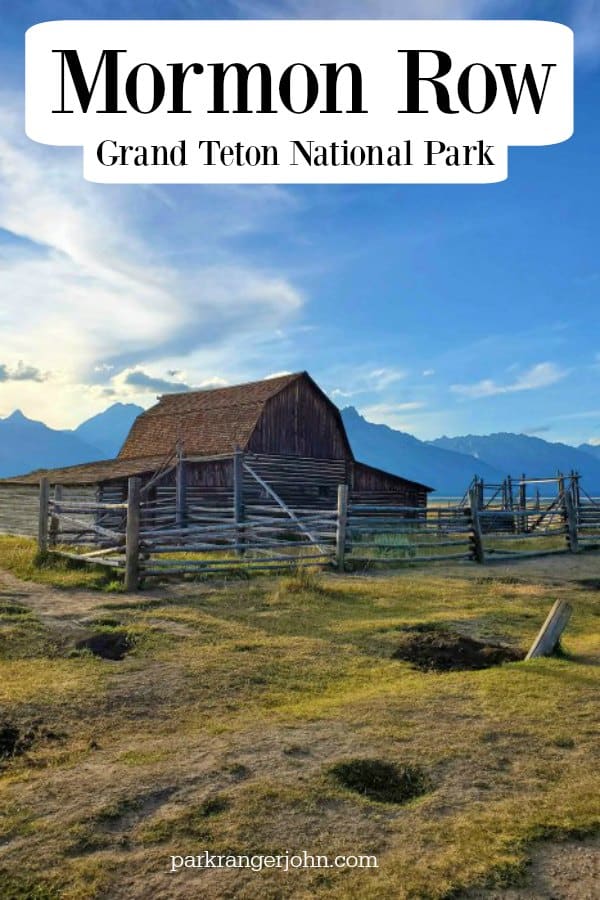
TL;DR Don’t have time to read the full article? Here are my top finds:
🏨Hotels and Vacation Rentals
📍Tours
🐻 Save time! Buy your National Park Pass before your trip
If you have been asking where is the barn I have seen in so many photographs of Grand Teton here is the answer!
Mormon Row Historic District - Grand Teton National Park
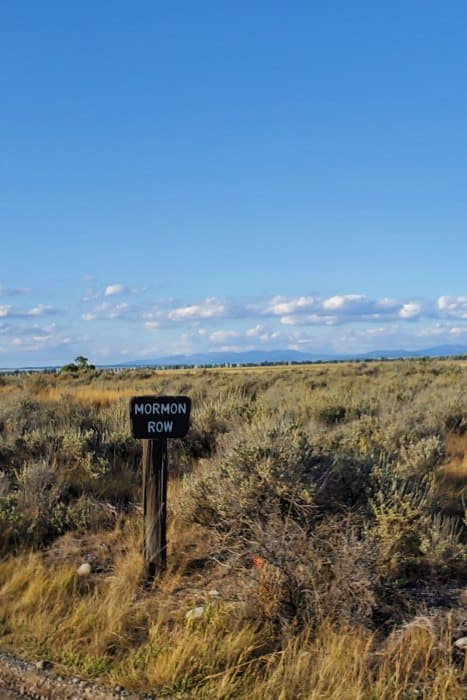
To understand Mormon Row, we must first understand homesteading in the United States as Mormon Row is a direct result of the Homestead Act of 1862 and the westward expansion of the United States.
There are several thoughts as to why the Homestead Act was signed into law including the 19th. Century concept of Manifest Destiny, a concept of U.S. territorial expansion to control the destiny of the United States from coast to coast and to spread progress and democracy to uncivilized regions.
Leaders of The Church of Jesus Christ of Latter-day Saints sent parties from Salt Lake Valley to establish new communities through homesteading to support the expanding population.
The Homestead Act of 1862
President Abraham Lincoln signed the Homestead Act on May 20, 1862. The Homestead Act gave citizens or future citizens up to 160 acres of public land provided they live on it, improve it, and pay a small registration fee.
After five years on the land, the original settler was entitled to the property free and clear! The Government granted more than 270 million acres of land under this act.
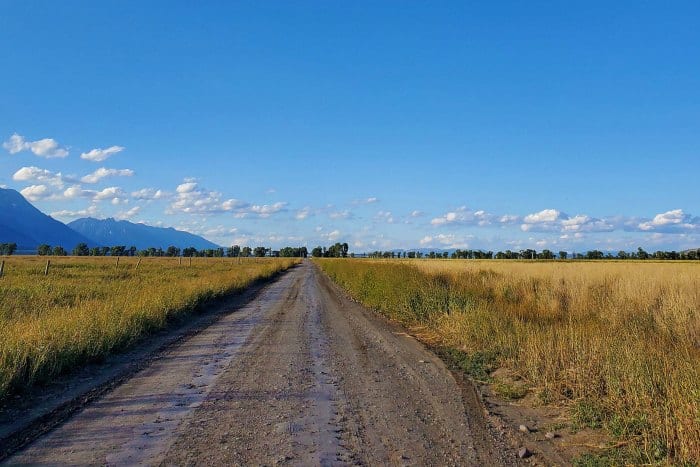
Historic Homesteads
The Mormon Row Historic District in Grand Teton National Park is home to several of the original 27 homesteads in this area. Today park visitors can see buildings from six of these homesteads as well as drive past where the school and church used to be located.
Mormon settlers picked this area as the soil was relatively fertile, Blacktail Butte provided much-needed shelter from the harsh winds and they were relatively close to the Gros Ventre River for access to water for both personal use and crops.
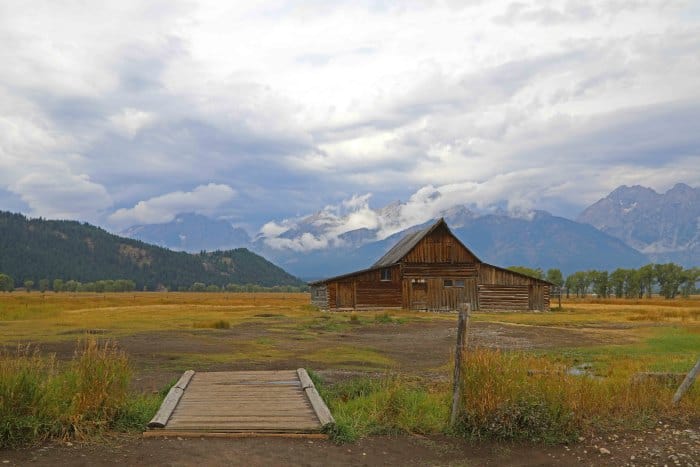
History of Mormon Row
The Mormon Row Historic District is located in the southeast corner of Grand Teton National Park, Wyoming.
When President Abraham Lincoln signed the Homestead Act in 1862, millions of acres of land was up for grabs in the great American West. A settler was granted 160 acres for free so long as he established a homestead and took care to use the land respectively.
Since the late 1840s, Mormon groups had been establishing settlements in Utah. Members of the Church of Jesus Christ of Latter Day Saints, also known as Mormons, began a thousand mile journey from what is now Middle America to the West.
These Mormons, led by Brigham Young, arrived in Utah in July of 1847 and began building what is now Salt Lake City.
In the 1890s, the Mormon community began sending parties out of the Salt Lake Valley to establish new communities and increase their religious population throughout the west.
Many groups had spread north through Idaho and in 1986, had eventually ended up in the valley now called Mormon Row in what is the present day valley of Jackson Hole.
Upon entering the area at the base of the Teton Mountains, the group was enchanted by the undeniable beauty of the valley.
In 1896, settlers named their newly established village Grovont, named after the Gros Ventre River, a tributary of the Snake River in Wyoming. Access to the river, fertile soil, and wind protection from nearby Blacktail Butte made the area attractive to settlers.
It was here that they established 27 settlements. Today, the area is one of the best existing examples of an early 1900’s farming community.
This historic district is a wonderfully preserved area significant for its history of people, architecture, and farming in the early 20th Century West. These farming homesteads were built close together to ensure a tight-knit community that was able to share work and duties.
This was different than other farms and ranches of the time which were in much more desolate locations. Growing season in this part of Wyoming was relatively short and winters were harsh.
The people of Grovont worked to dig an intricate network of ditches to supply water where needed. Today, water still flows in some of these ditches.
The town of Grovont contained multiple ranches, homes, a church, and a school with the beautiful, towering Teton Mountain Range acting as background landscape throughout.
Built in 1916, the church was the central building of the village and played a large part in faith and social gatherings. Although the church was later moved to Wilson, Wyoming, its original spot in Mormon Row is marked by fence posts.
Important natural features in the area include The Knoll, which was a sledding hill for the children, and the remains of the community swimming hole.
Still existing today is the homestead of John and Bartha Moulton. The homestead includes their more modern pink stucco home and their iconic barn.
Arguably one of the most famous barns in America, photographers and visitors travel from all over the world to snap a photo of this barn with the snowy Teton peaks perfectly lining the background.
South of this homestead lies what is left of the Thomas Alma and Lucille Moulton homestead. The barn seen here took Thomas over 30 years to build and is as beautiful as his brother John’s.
John and Thomas arrived in Grovont together in 1907. They each filed for 80 acres of land and began clearing the way for their adjacent homesteads. John first met Bartha through his sister-in-law Lucille.
Bartha and Lucille were sisters and when Lucille was due to give birth, Bartha traveled from Idaho to assist her. By 1917, Bartha had married John and moved to the ranch on Mormon Row.
John was well known in the valley for his dairy business, as well as his pink house. The home wasn’t always pink.
When John’s wife Bartha was in the hospital he wanted to do something special for her return. By mistake he purchased the salmon pink colored paint and painted the entire house. It was said that Bartha despised the color, but appreciated his intentions more so the color was never painted over.
The most intact homestead located here is that of Andrew and Ida Chambers. Andrew settled the area in 1912 and built a log cabin, a stable, and cleared land for crops.
He also eventually built a windmill to produce his own electricity, which still stands today as well. Andrew was the last man to establish a homestead on Mormon Row after purchasing land in 1912. Andrew married Ida in 1918.
She was already living on Mormon Row and worked as the village schoolteacher. Sometime in the early 1920s, the couple bought the nearby Eggleston land and built a two story wood frame house.
The Chambers ran the town post office from their home for nearly nine years and frequently offered meals and rooms to people passing through. Sadly, in 1936, the two-story home burned down. The family moved back into their original log cabin.
Grand Teton National Park was established in 1929 and by 1950, agricultural development was halted due to the expansion of the park. By then, Mormon Row as acquired by the National Park Service as part of the Grand Teton National Park.
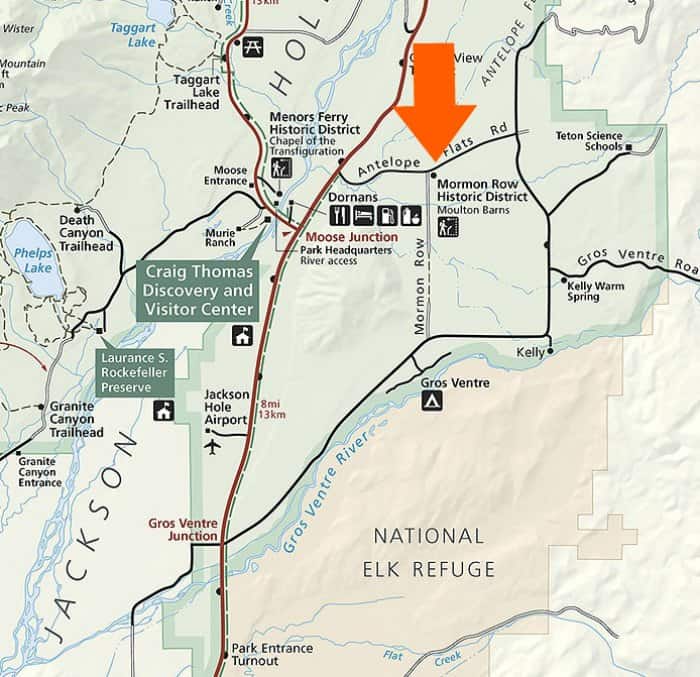
Where is Mormon Row Located?
If you are driving from Jackson, Wyoming drive northbound on Highway 191. You will pass the Jackson Hole Airport and continue to go North of Moose Junction.
Shortly after passing Moose Junction you will take a right onto Antelope Flats Road. Drive 1.5 miles east until you see a dirt road on the right and the pink stucco house (Moulton Ranch) on the left.
You have arrived at Mormon Row. There is a parking lot on both the left and the right side of the intersection. The parking lot on the right has a vault toilet.
The dirt road can be traveled towards Gros Ventre Campground easily.
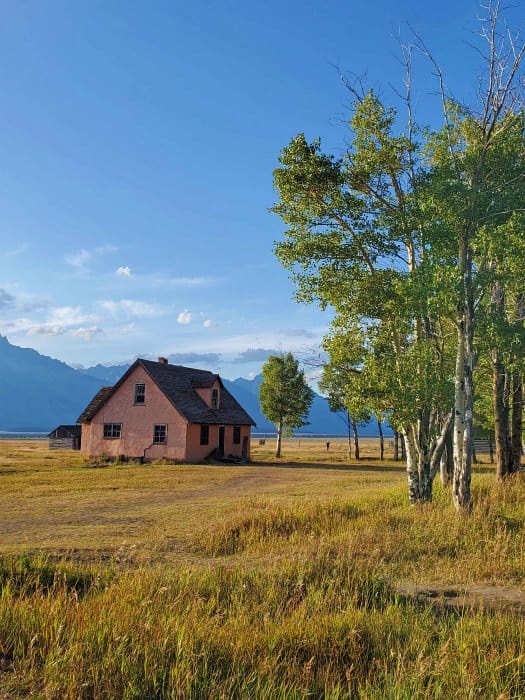
Moulton Homestead
There are two Moulton Homesteads located on Mormon Row and the Moulton Barns is one of the iconic images that park visitors come here to see. The homestead of Bartha and John Moulton is on the Northside of Antelope Flatts Road. Here you will find the Moultons pink stucco house and barn.
The barn on the Southside of Antelope Canyon Road is the only building remaining from the Homestead of Lucille and TA Moulton. The TA Moulton Barn is perhaps one of the most iconic photos of Grand Teton National Park.
This classic photo depicts the Moulton Barn in the foreground and the snow-capped Teton Range in the background. This image alone has attracted photographers from around the world to capture its beauty!
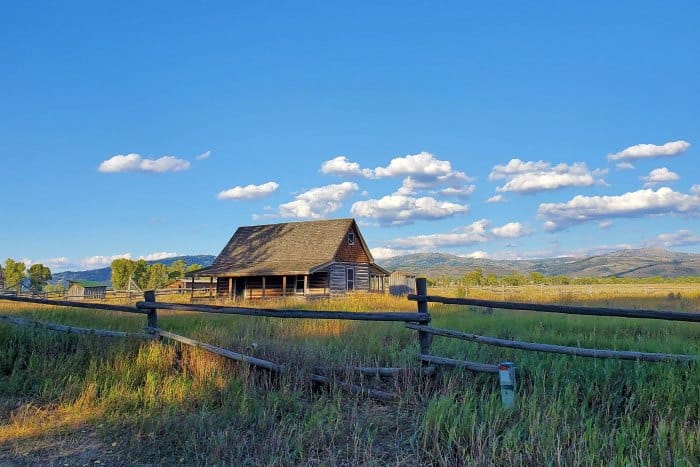
Chambers Homestead
Just past the two Moulton Homesteads is the Ida and Andy Chambers Homestead. Chambers claimed the land in 1912 and is the most extensive historic complex on Mormon Row today.
The Chambers Homestead got running water in 1927 and then electricity by installing a windmill in 1946 which still stands today. This was important as Mormon Row did not get power from the rural electric administration until the 1950s. By the 1950's most of the homesteads had sold their land to the National Park Service.
The Chambers Homestead was added to the National Register of Historic Places in 1990 as a Historic District and then included as part of the larger Mormon Row district in 1997.
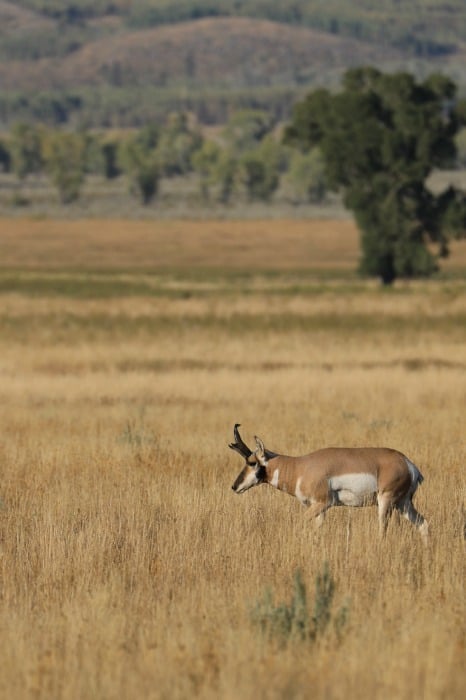
Wildlife Viewing near Mormon Row
There is great wildlife viewing along Antelope Flats Road. You can see antelope, moose, coyotes, ground squirrels, bison, and possibly bears. This is considered bear country with both Black Bears and Grizzly Bear present in the park.
Keep your camera ready but also always be aware of what else in enjoying the views near you.
Camera Gear we use
We are big fans of using great camera gear to get amazing photos while traveling.
Canon R5 - We recently upgraded to the R5 after using a Mark 5 for years. We are loving the camera shutter speed and quality of images.
Canon 100 - 500mm - We use the Canon 100-500 for wildlife photography.
Camera Rain Cover - A rain cover will help protect your camera during rain showers but also when photographing waterfalls.
Camera Cleaning Kit - Cameras can get dirty, beat up, and dusty while in the parks. We like having a cleaning kit with us so we can do on the spot touch ups.
Extra Camera Batteries - We suggest always having one or two extra camera batteries with you. There is nothing worse than going to take a shot and the battery dies.
Extra Memory Cards - We use Extreme PRO SanDisk cards
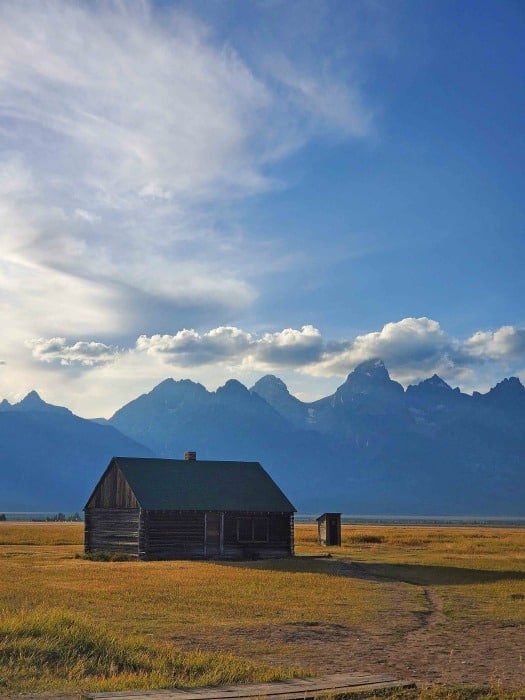
Additional Grand Teton National Park Information & Resources
Grand Teton National Park Guided Tours
Tetons and Snake River Scenic Float Trip in Jackson Hole
⭐️ Rating: 4.8 out of 5 Stars | ⏳ Tour Length: 3 hours | 🛶Check Rates and Availability
This would be, without a doubt, the tour I would choose! Take a relaxing rafting trip from Jackson Hole, drift down a scenic section of Wyoming's wildlife-laden Snake River, where moose, deer, river otters, and eagles can be seen from your raft. Be sure to bring your camera to photograph any wildlife that appears on the banks, and also capture the stunning landscape extending out from the Tetons.
Grand Teton Wildlife Safari in an enclosed or Open-Air Vehicle
⭐️ Rating: 4.9 out of 5 Stars | ⏳ Tour Length: 4 hours | 🚌Check Rates and Availability
Join a local naturalist and guide for a ride in an open-air safari vehicle (seasonal) on dirt roads and on paved highways within Grand Teton National Park, where you scour the landscape at dawn or dusk for wolves, moose and elk. Look for eagles soaring overhead or deer walking through the woods, and there's even a chance that you can spot a bear roaming near the road. The guides also discusses the areas ecology, history, geology, and culture, and also stops so that you can take photos.
Grand Teton Half-Day Tour
⭐️ Rating: 4.8 out of 5 Stars | ⏳ Tour Length: 4 hours | 🚌Check Rates and Availability
Explore the highlights of Grand Teton National Park from either Jackson or Teton Village. Travel along the Gros Ventre River to the Mormon Row Historic District, Moose Junction, and other places where wildlife roam. Use the provided spotting scope and field glasses to get a close look at the animals like moose, elk, and eagles.
Grand Teton National Park Lodging Options
Lodging in Grand Teton National Park
Grand Teton National Park has several National Park lodges, including Signal Mountain Lodge, Jenny Lake Lodge, Jackson Lake Lodge, Headwaters at Flagg Ranch, Triangle X Dude Ranch, and Colter Bay Village Cabins.
Signal Mountain Lodge
🏨Ready to Book the Signal Mountain Lodge -> Click Here
Why Book here? How about rooms with jaw-dropping EPIC Views of Jackson Lake in the foreground and the Tetons in the background! There is nothing quite like sitting on the deck with a cup of coffee watching sunrise. The Signal Mountain Lodge is open from Early May to mid - October.
Jenny Lake Lodge
🏨Ready to Book the Jenny Lake Lodge -> Click Here
Why stay here? This is by far, the closest accomodations to Jenny Lake and all of its wonders! Now you can get to the parking lot early and beat the insane crowds trying to get to this piece of heaven. The cabins are secluded and located east of Jenny Lake, this resort is a high-class destination for the well-pampered traveler. The dining room offers a prix fixe menu with a local and international flair. Open Early June to Early October.
Jackson Lake Lodge
🏨Ready to Book the Jackson Lake Lodge -> Click Here
Why stay here? The main lodge area is absolutely EPIC with sweeping panoramic views of the Teton Range and Signal Mountain from the full wall of windows! Don't forget to hang out by the fireplace and stop in a restaurant to enjoy the full lodge experience.
With spectacular dining in the world-renowned Mural Room, shopping opportunities in its three gift shops, guided activities, and a comprehensive conference facility. Its easy to see why this lodge draws thousands of guests from May through October each year.
Headwaters at Flagg Ranch
🏨Ready to Book the Headwaters at Flagg Ranch -> Click Here
- Season - Early June to Late September
Why stay here? Location, Location, Location! The Headwaters Lodge at Flagg Ranch is actually located on the Rockefeller Memorial Parkway just South of Grand Teton National Park, and just North of Yellowstone National Park. The cabins are very nice and makes it easy to explore both parks in one convient location.
Colter Bay Village Cabins
🏨Ready to Book the Colter Bay Village Cabins -> Click Here
Why stay here? these cabins are so cute and give the log cabin feel! They also provide easy access to the Colter Bay Marina and village. The historic cabins are over 90 years old and feel like you are stepping back in time but still have modern amenities. Open from Late May to Late September.
Lodging near Grand Teton National Park
Four Seasons Resort Jackson Hole
🏨Ready to Book the -> Click Here
Do you want to stay in a hotel with 5-star old luxury charm, phenomonal spa treatments, concierge, and delicious dining? Consider a stay at Four Seasons Resort Jackson Hole and take advantage of the nightclub, and a terrace. Yoga classes are offered at the health club. Free in-room Wi-Fi is available to all guests, along with a hair salon and an arcade/game room.
Fireside Resort
🏨Ready to Book the Fireside Resort -> Click Here
Why Stay here? Super cute small cabins right off the Moose-Wilson Road! Cabins feature a spa tub, coffee/tea in a common area, and concierge services. Free Wi-Fi in public areas and free self parking are also provided. Additionally, laundry facilities, tour/ticket assistance, and a garden are onsite. All 20 cabins boast fireplaces and offer free Wi-Fi and kitchens. Patios and living rooms are standard, as are flat-screen TVs with cable channels.
Click on the map below to see additional vacation rentals and lodging options near the park.
Grand Teton National Park Entrance Fee
Park entrance fees are separate from camping and lodging fees.
Park Entrance Pass - $35.00 Per private vehicle (valid for 1-7 days from the date of purchase)
Park Entrance Pass - Motorcycle - $30.00 Per motorcycle (valid for 1-7 days from the date of purchase)
Per-Person Entrance Pass - $20.00 Visitors 16 years or older who enter on foot, bicycle, or as part of an organized group not involved in a commercial tour.
Annual Park Entrance Pass - $70.00, Admits pass holder and all passengers in a non-commercial vehicle. Valid for one year from the month of purchase.
$25.00 for Commercial Sedan with 1-6 seats and non-commercial groups (16+ persons)
$125.00 for Commercial Van with 7-15 seats
$200.00 for Commercial Mini-Bus with 16-25 seats
$300.00 for Commercial Motor Coach with 26+ seats
Learn more about National Park Passes for parks that have an entrance fee.
$80.00 - For the America the Beautiful/National Park Pass. The pass covers entrance fees to all US National Park Sites and over 2,000 Federal Recreation Fee Sites for an entire year and covers everyone in the car for per-vehicle sites and up to 4 adults for per-person sites.

Buy your pass at this link, and REI will donate 10% of pass proceeds to the National Forest Foundation, National Park Foundation, and the U.S. Endowment for Forestry & Communities.
National Park Free Entrance Days -Mark your calendars with the free entrance days the National Park Service offers for US citizens and residents.
Grand Teton and Yellowstone Information
Grand Teton Camping Guide - Learn more and see photos of every campground within Grand Teton NP.
Jackson Lake Lodge - Find out what to expect when staying at the lodge including photos and video.
Epic List of National Park Lodges - Find out more about all of the historic lodges in National Parks
National Parks in Wyoming - Check out the other parks you can visit during your vacation
Things to do in Yellowstone National Park
Make sure to follow Park Ranger John on Facebook, Instagram, Pinterest, and TikTok

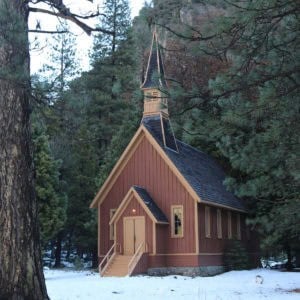
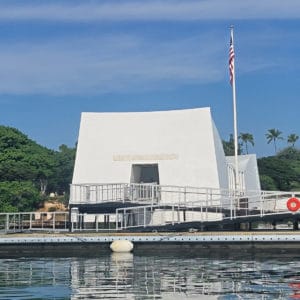
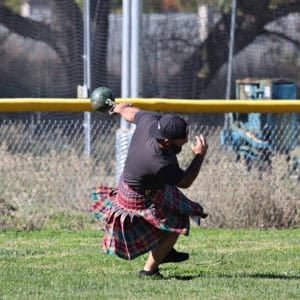

Leave a Reply